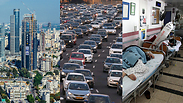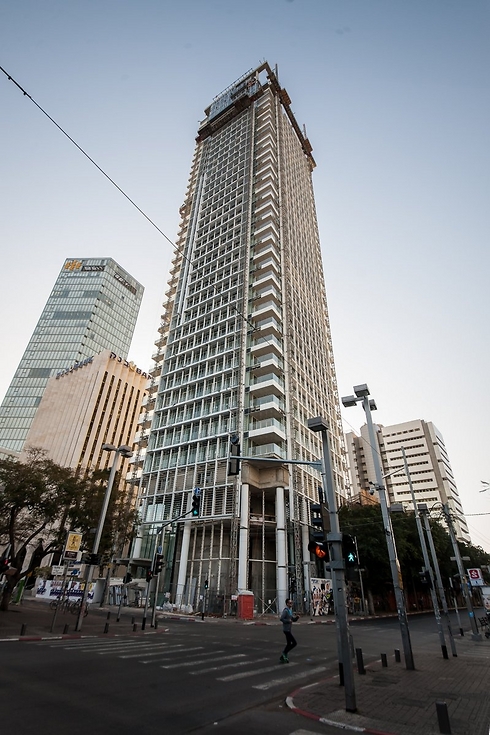
Israel 2065: Overcrowded and elderly
The Central Bureau of Statistics' forecast for Israel in 50 years projects a population of between 15.8 and 25 million inhabitants with 30% being over the age of 65; experts disagree on whether the country will be able to deal with the result of an unusually high birth rate but agree that the current infrastructure will most certainly be insufficient.
The Central Bureau of Statistics (CBS) released a worrying forecast on Thursday for the Israel of 2065, which is expected to be an extremely overcrowded and country with an aging population.
Fifty years from now, the country's population is projected to be between 15.8 million and 25 million, according to the CBS. This increase in number of inhabitants is expected to worsen currently existing problems, such as housing availability, traffic jams, overloaded infrastructure and an aging population.
Dr. Ahmad Hleihel, the senior deputy director of CBS's Demography Sector, explained to Ynet, "In Israel, we continue to have more children. The crowdedness will rise from a level of 370 persons per square kilometer to more than 900 persons per square kilometer."
Demographer Prof. Arnon Soffer of Haifa University is pessimistic as well. "It's a nightmare—a sad forecast," he said. "There's a terrifying number of 15 to 25 million persons who will live in this country. To think that we'll be the most crowded country in the Western world: Moving on the roads is impossible; violence covers every square inch; a housing crisis—and all this will worsen with the growth of from eight to 15 million persons."
Soffer proposes the solution of reducing birth rates in Israel. "We're increasing like the Third World," he explained. "We must reduce natural growth; otherwise, all of us will be hungry. Even today, it's impossible to move on the roads. Highway 6 should already have been widened and public transportation should have been improved; there's a feeling of national emergency. Israel is a small country and is drying out with climate change. Half of its territory belongs to the IDF, and it's not about to change."
According to Soffer, the biggest victims of the rapid population growth will be the residents of the Galilee, the Negev and Jerusalem, all of which he defines as belonging to the periphery due to their poverty rates. "The periphery is already sick today," he said. "And those in the periphery remain weak because the strong make their way to Tel Aviv. The State of Tel Aviv is a threat to Israel, and if it doesn't return to being part of it, we won't have either one."
Proper planning
Dr. Yoav Lerman, an expert on urban planning with the consulting firm Planet, qualified the apocalyptic predictions: "There's room for 20 million persons in Israel, but what will determine if comfortable life is possible here isn't how many persons there will be, but rather what the infrastructure development will be." Lerman emphasized urban planning and the public transportation system: "If the assumption is that everybody is going to get around in a car, it could be very complicated."Lerman elaborated, "Today, there are already 3.5 million persons living in metropolitan Tel Aviv, and it's likely going to end up like Los Angeles where, if you want to buy milk, you have to allot 50 minutes for the trip. The planning must be such that will allow the movement of a large population without using private cars. Therefore, there must be greater reliance on rail and planning."
Predicting what will be Israel's main metropolis 50 years from now, Lerman indicated the entire area between Haifa and Jerusalem: "It won't be a contiguous built-up area, but functionally and economically, it will be one area that will encompass the entire coastal plain to Ashkelon. In that space will be 80 percent of Israel's population."
Lerman did not leave much room for the periphery, but he was convinced that Be'er Sheva as it is today will not be able to meet the needs of the Negev: "We must see to it that Be'er Sheva will be a normal city. Today, it gets more from the state than it produces itself. Its large institutions—the hospital and the university—they aren't economic, and the city is weak from a business standpoint. The northwest of the country will have more calm and peaceful life."
Contrarily to Soffer, Lerman is not concerned by a shortage of food and drinking water, but he is worried about the lack of planning in Israel: "There are cities smaller than the area of the State of Israel with more residents than 20 million. Food will have to be imported from abroad, of course; it's not a big deal. The question is whether there will be rational and efficient economic development that is based on rail, infrastructures, efficiency, concentrating people and not dispersing them on the basis of train station. Today, new cities in Israel are planned based on highways and not on railroads. The current policy will not manage to cope with this challenge. I'm certain that the decision makers know this, but it requires synchronization between the various entities, and the political leadership must show the way."
Reaching skyward unwise
Prof. Rachelle Alterman, a senior researcher at the Samuel Neaman Institute for National Policy Research at the Technion, also warned of poor city planning and insisted on separating crowdedness and building upwards, despite the current tendency in Israel to build taller buildings for its increasing population.
Like Soffer, she pointed to the country's unusually high fecundity: "Israel's birth right is three times higher than OECD countries'. We've moved to (that of) Iran, Tunisia, Turkey, Algeria and others. The combination of building tall buildings for the middle class and beneath along with the high birth rate, has not been tried in any other country in the Western world.
"The towers are an absolute formula for deterioration. Real maintenance of the towers requires investments… The real maintenance cost for 30 or 40 years is about NIS 1,500 per month, and of course middle class families can't meet these sums."
Alterman believed that as a result, in another 20 years, the buildings will become overcrowded housing projects: "Today the National Outline Plan adds more stories. More stories can't be added atop a tower. Who will renovate them? Who will maintain them? They'll have to be demolished and rebuilt, and who will bankroll these expenses?"
Aging population
The CBS's forecast also indicates that the overcrowded Israel of 2065 will be considerably older. In 2015, more than 15% of the country's general population is over the age of 65. In 2065, that percentage is expected to double. The CBS predicts that 422,000 persons over the age of 90 will live at that time in Israel.
The Israel Gerontological Society's chairman, Prof. Yitzhak Brick, summed up the situation, "In a word, there's going to be a catastrophe. The health system will collapse. The aid system will collapse. Today, hospital occupancy is at 100% of beds, and most of the patients in internal medicine departments and emergency rooms are old people. We already see the problem today.
"The country must draw up and prepare a national master plan today. Even though there's a pensions law, not everybody is ensured, but only 50% of 65 year olds and above, and benefits for the elderly don't allow living in dignity. We're in a serious problem, and its deterioration will create a dangerous situation."












